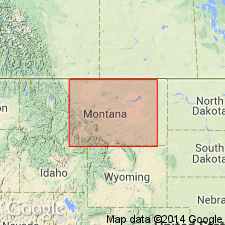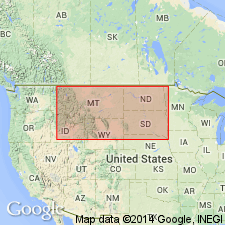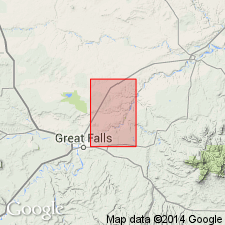
- Usage in publication:
-
- Sunburst Sandstone Member*
- Modifications:
-
- Areal extent
- AAPG geologic province:
-
- Sweetgrass arch
- Central Montana uplift
Summary:
Shown as basal member of the Lower Cretaceous Kootenai Formation unconformably above Swift Formation between sec 14, T37N, R12E and sec 5, T18N, R21E or between Hill Co, MT (north) to Fergus Co, MT (southeast). The area runs from the northeast part of the Sweetgrass arch to the northern part of the Central Montana uplift. Shown as equivalent to the Third Cat Creek sandstone, an informal unit at base of Kootenai to east, and farther southeast as equivalent to the Pryor Sandstone Member of Kootenai of Yellowstone Co, MT on the Central Montana uplift. Tongues into the Moulton Member of the Kootenai to west in Toole Co, MT on the Sweetgrass arch. Overlain by unnamed part of Kootenai.
Source: GNU records (USGS DDS-6; Denver GNULEX).

- Usage in publication:
-
- Sunburst Sandstone Member*
- Modifications:
-
- Principal reference
- Dominant lithology:
-
- Sandstone
- AAPG geologic province:
-
- Sweetgrass arch
Summary:
Sunburst Sandstone Member, middle member of Kootenai Formation. Sunburst sand (economic term) adopted as Sunburst Sandstone Member of Kootenai Formation. Originally called Lander Member (preempted) by Oakes (1966). Consists of a medium- to coarse-grained white to tan sandstone containing scattered multi-colored chert grains. An abundance of white bentonite clay cement controls porosity of the Kevin-Sunburst field (Perry, 1928, pl. 14). In the Cut Bank area, the upper part of the Sunburst is a bright red partially mottled mudstone. Overlies Cut Bank Sandstone Member (revised) and underlies Moulton Member (revised), both of Kootenai. In the type area, unconformably overlies Upper Jurassic Swift or Morrison Formations.
Type section (subsurface): depth-interval 1,220 to 1,245 feet (372 m to 380 m), Johnson No. 1, Johnson "D" well, in NW/4 NW/4 sec. 32, T. 35 N., R. 1 W., Kevin-Sunburst dome, Toole Co., MT.
Source: Changes in stratigraphic nomenclature, 1975 (USGS Bull. 1422-A, p. A38-A39, A66-A67).

- Usage in publication:
-
- Sunburst? Member*
- Modifications:
-
- Areal extent
- AAPG geologic province:
-
- Sweetgrass arch
Summary:
Tentatively correlated with Sunburst Member of Kootenai Formation that occurs in subsurface on Kevin-Sunburst dome. Mapped with lower part of Kootenai Formation. Study area is in Cascade and Choteau Cos, MT, Sweetgrass arch. Described as massive- to cross-bedded sandstone, 82 ft thick at base of Kootenai. Unconformably overlies Morrison Formation. Early Cretaceous age.
Source: GNU records (USGS DDS-6; Denver GNULEX).
For more information, please contact Nancy Stamm, Geologic Names Committee Secretary.
Asterisk (*) indicates published by U.S. Geological Survey authors.
"No current usage" (†) implies that a name has been abandoned or has fallen into disuse. Former usage and, if known, replacement name given in parentheses ( ).
Slash (/) indicates name conflicts with nomenclatural guidelines (CSN, 1933; ACSN, 1961, 1970; NACSN, 1983, 2005, 2021). May be explained within brackets ([ ]).

